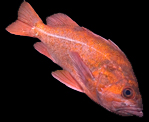
Tanker Reef
Tanker Reef's most notable features are two to three foot high shale ledges. One of these ledges forms what's almost certainly the most productive harbor seal hunting ground I've encountered. Like many large reef predators, harbor seals rely on their ability to trap prey in a corner more than their speed. It's therefore not surprising that a collection of fissures and overhangs populated with reef fish and just wide enough to accommodate a seal's girth provides excellent opportunities for our whiskered friends to find lunch. This is exactly the topology that can be found at Tanker. Seals often patrol the ledge with determination, occasionally plunging the noses into a recess, only to reappear moments later with silt smears on their faces and, presumably, a satiated appetite. There's more to delight a seal at Tanker than just the promise of food, however. A lush kelp canopy and almost invariably opaque green layer of surface water can be used to hide a seals silhouette form predators such as white sharks or Orcas. The reef's merits appear to no secret among seals. Often as many as six or more crammed into an area the size of a modest back yard. Why the seals haven't managed to entirely clean out the local fish, I don't know. Perhaps, fish recruitment in this area is particularly strong. Given that there really isn't any other kelp forest habitat in the immediate vicinity, perhaps more young fish settle out of the plankton here than in other places. Of course, Tanker has more than just harbor seals. Those looking for a change from Monterey and Carmel's usual offerings may enjoy observing fringeheads inhabiting holes bored by clams or encounter swarms of breeding Melibe leonina aggregating on kelp blades. Tanker is certainly an excellent nursery for juvenile rockfish and a great place to see both small vermilion rockfish and great schools of young of the year bocaccio. A well-trained eye can frequently spot octopus lurking at the mouths of their dens at Tanker, even during daylight. Masters of camouflage, octopuses (yes, it is octopuses and not octopi) can change both color and texture almost instantly. Most often their presence is only betrayed by their retreat into a hiding place as diver approaches. Since Tanker is in the deepest recesses of Monterey Bay, conditions are usually pretty calm. I often come here to chill out for a bit after getting beat up by some more challenging site. If you need some place to regain your sea legs, this is and excellent choice.
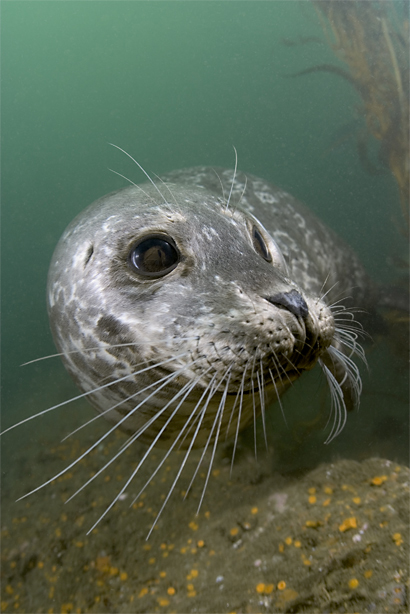
Always wary, harbor seals (Phoca vitulina) spend a great deal of time
scooting along, just a few inches off the bottom. Presumably, this makes it
difficult for predators and prey alike to detect their presence. Since the lens
used in this shot makes the subject appear farther away than it really is, it
may not have occurred to you to wonder why this animal, merely inches from the
camera's dome port is looking at something off to the photographer's right. If I
recall correctly, the animal came this close because it was attracted to the
port itself - they're very shiny underwater. While harbor seals seem to really
like camera ports, they have something of a love/hate relationship with strobes.
On the one hand, strobes such as the YS-90s I was using on this dive are, like
ports, shiny since their outer casings are transparent. On the other hand, they
emit terrible, scary flashes. About five minutes before this shot was taken, an
itchy trigger finger got the best of me and I pressed the shutter while this
seal was still about eighteen inches away. In this position, it was looking
almost directly into the strobes and winced in obvious annoyance. I cursed
myself for being so careless, but the damage was done. In this later shot, the
seal is actually looking at one of the strobes, I suspect with some concern.
Harbor seals are quick to learn how to avoid getting hit with strobes or focus
lights. Once educated, they may still tug on your fins, chew on an offered hand,
and even check out the non-flashy sides of strobes using the universal harbor
seal kiss of investigation (lips parted, mouth closed and pressed against the
object of interest). However, raise your camera, any you'll most likely end up
with nothing but the south end of a north bound seal. Should you find yourself
in such a position, It's time to turn off the camera and just enjoy the moment.
"Tanker Reef", Monterey Bay, California
November 27, 2005
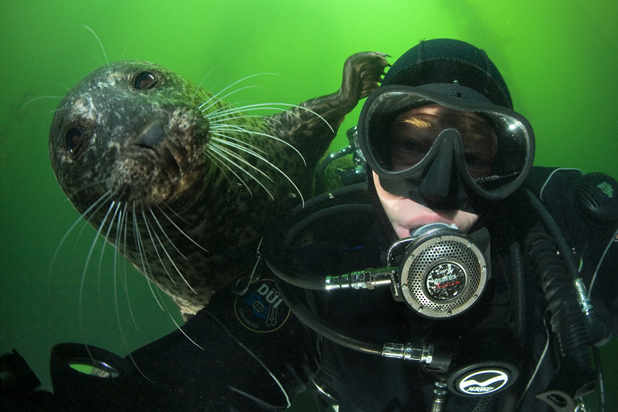
. . . and just when I was all set to take one of my very best self-portraits
ever, someone had to stick his nose in the shot and mess up everything! This
harbor seal (Phoca vitulina) is doing a pretty good job of pushing me
aside. Yes, those are his claws on my head. And yes, they're sharp and can be
felt through a drysuit hood, even the half-inch one I'm wearing. Note the
quarter-inch of water in the bottom of my mask. This is a side-effect of
roughhousing with the fuzzball -- or maybe it's just from an intense fit of the
giggles. This guy is quite the bully, actually. On this dive I'd spent over an
hour playing with a seal that was bit by bit working up enough the courage to do
something more than sneak up from behind to give a little fin tug. A few seconds
before this shot was taken, this original animal was chased off by the snarls of
the animal pictured. Proof, I guess, that competition in nature can be pretty
fierce, even in the pursuit of leisure -- and, I'm pretty sure this is what they
have in mind. Certainly, I'm sure they've figured out by now that my fins aren't
edible. You can't actually see my fins in this shot, you can clearly see some of
the other gear choices I've made (both good and bad). You'll have to indulge me
as I blab about dive gear for a bit. If you don't want to humor me in this
regard, well, then you can just move on to the next caption or something. First
off, photographers (artists that we are) often dress entirely in black. Clearly
that's what I'm doing. Black is pragmatic, (it doesn't show dirt and all), but
is a poor choice if you're going to be someone else's model. Everything black
gets swallowed up into one giant blob. Worse yet, every teeny, eeny, bit of
backscatter looks like a great big honking chunk when it's in front of a black
background. When choosing a color, consider blue, it looks great. My next suit?
Black with white speckles. Why? It's the only color in which the material I
wanted is available. At least, maybe the backscatter will be hidden among all
the speckles. The hood I'm wearing is a custom Otter Bay Wetsuits hood. Pure
genius, these hoods. You have no excuse for not owning one -- well, maybe if you
live in Nebraska you have an excuse, but certainly not if you're a diver, cold
or warm water. The one catch with the Otter hood is that it comes with a giant
Otter Bay logo. I could do without this, I consider it to be in much the same
league as license plate frames emblazoned with a auto dealer's name. I own dry
gloves which are bright blue -- again due to limited availability of colors.
While these have unintentionally made their appearance in far more than one shot
they thankfully can't be seen in a standard self-portrait like this one. This
mask is proof that the best gear is not always the most expensive. In fact,
apart from what you find at the drug store, this Oceanic Mini Shadow is about
the least expensive mask I've seen. If it fits you, buy one. If it doesn't
there's a non-mini version of the same mask so you might try that one. If that
doesn't fit either, then, well, too bad for you. I should admit that while I
don't represent Oceanic in any formal capacity, they have been paying customers
in the past. It's still a good mask, you have my word on it. Of course, I've
made some not-so-good gear choices also. Take the primary regulator I'm using
here (the thing in my mouth). It's plated with 100% pure unobtainium so it was
really spendy. Why? No reason, I just couldn't stand the thought that somewhere,
somehow, there might maybe be someone with more expensive gear than mine. Dive
gear manufactures are fond of such gimmicks. With a little bit of rational
thought (hard for some of us, I know) it shouldn't be too hard to avoid most of
these.
"Tanker Reef", Monterey Bay, California
October 22, 2006
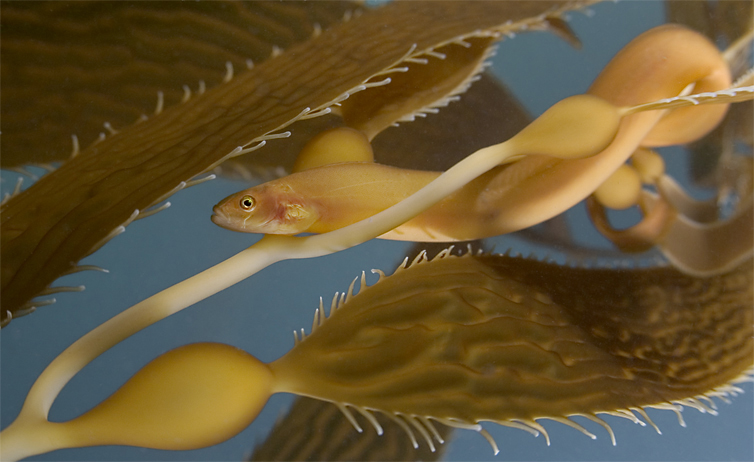
One of the more cryptic denizens of the Monterey bay, kelp gunnels (Ulvicola
sanctaerosae) like this one often display remarkable tail dexterity. If one
is fortunate enough to see this animal at all, it can be quite difficult to
visually trace it from end to end due to it's ability to wrap its tail in
improbably tight coils around stipes of kelp. Small animals that hide in giant
kelp almost universally use the same, very simply, mechanism to deter predators
(and photographers). When discovered, they simply move to the back side of the
stipe on which they're resting. Easy for them, they only have to move a tiny
bit, but a predator/photographer has to move several feet in order to regain
their original view. Of course, what works once, works twice or three times as
well, and you can imagine who usually gets the upper hand in this exchange. I've
tried rolling the kelp's thallus in my fingers to present subjects to the
camera, it doesn't work as well as you might think. The classic solution to this
problem is to place a hand on the backside of the stipe to scare the subject to
the camera side. This works somewhat for wide angle shots if you can get your
scaring hand out of the shot before the subject slips behind the stipe again. It
doesn't work well for macro since it's quite difficult to keep the camera rig
steady with one hand.
"Tanker Reef", Monterey Bay, California
December 4, 2005
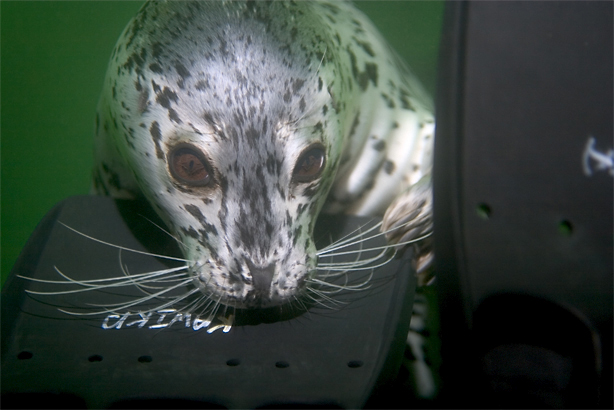
Photographer's fins and a furry dive companion with a foot fettish. A harbor
seal (Phoca vitulina) may introduce itself by biting and pulling on a
diver's fins. The pull feels quite similar to entanglement in kelp. This,
coupled with the fact that these animals are quite capable of vanishing from
view faster that one can turn around has often led me to wonder if I was having
hallucinations. I've felt tugs three, four, five times during a dive, before
catching a glimpse of the culprit. Eventually, the nibbler may work up the
courage to move beyond just fins. I've had seals tuck themselves under my arm,
or mouth hands, lights, and camera strobes. On several occasions I've even seen
them belly up in front of me in seeming demand of a tummy rub. Harbor seals seem
to treat contact with their own swimming flippers (though not their forward,
steering ones) as a sign of aggression. Perhaps this isn't surprising since a
seal with disabled hind flippers would almost certainly be unable to hunt and
would therefore perish. It may then be that fin nibbling is some kind of mock
dominance or a way to test the disposition of unfamiliar creatures. It may also
be that these young animals are simply practicing a defense skill that they'll
use throughout their lifetime. On one occasion, I was chased off -- away from
what, I'm not entirely sure -- by an adult harbor seal who nipped at my ankles
(not fins) with real force.
"Tanker Reef", Monterey Bay, California
September 4, 2005
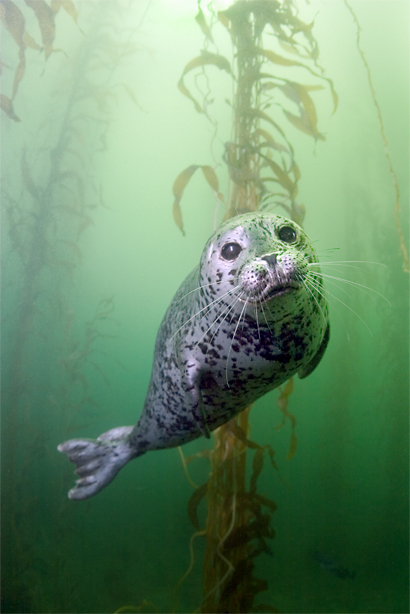
Harbor seals (Phoca vitulina) seem to expend almost no effort as they
glide through the kelp forest. However, it's uncommon to get a view like this
one. These animals, even when in the mood to play, will almost always approach
such that a would-be photographer doesn't see them coming. There was a little
bit of chicanery and a fair bit of luck involved in getting this pup to pose
like this.
"Tanker Reef", Monterey Bay, California
September 24, 2005
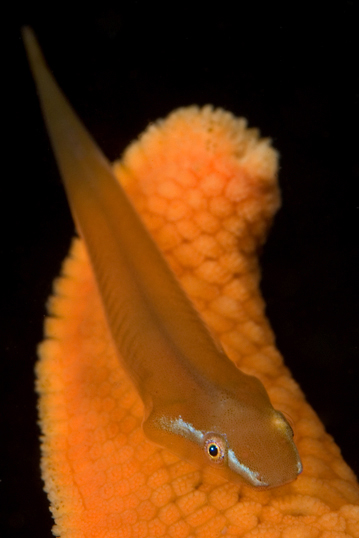
This kelp clingfish (Rimicola muscarum) has taken on a reddish hue to
blend in with a bat star (Asterina miniata). Perhaps this is an effective
defense against predators. However, their most effective defense against
photographers is to simply hop on to any camera that comes within a few inches
of them. Should a thwarted photographer then be foolish enough to closely
inspect a Rimicola that's decided to perch on his camera, it's likely
that this little fish will then attach itself somewhere on the photographer's
torso. It's remarkably hard to locate one's subject once this has happened. I
usually don't even try.
"Tanker Reef", Monterey Bay, California
November 11, 2006
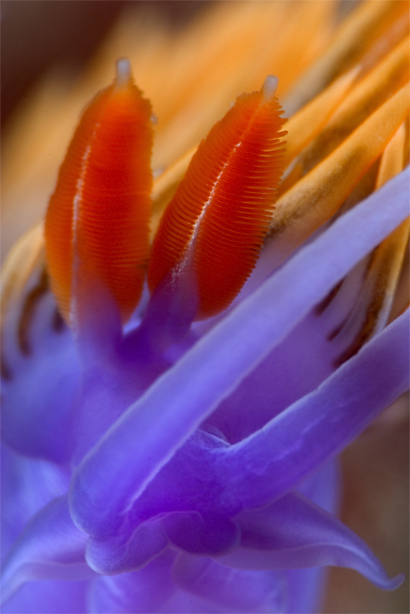
Close-up of a spanish shawl (Flabellina iodinea).
"Tanker Reef", Monterey Bay, California
April 2, 2006
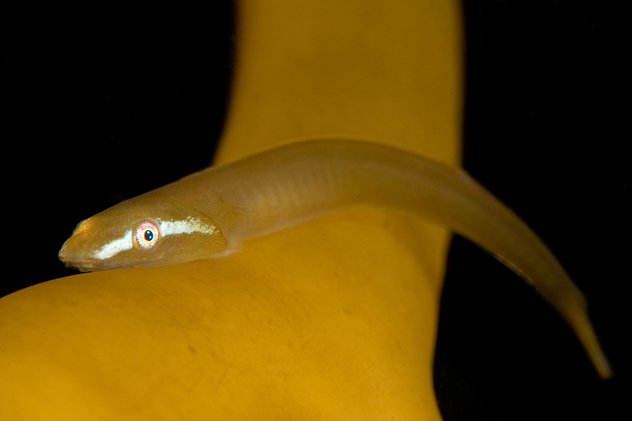
This kelp clingfish (Rimicola muscarum) is, not surprisingly, clinging to
a stipe of giant kelp (Macrocystis sp.). Clingfish are not uncommon, but
have rather cryptic habits and are therefore often overlooked. I spent the
better part of a 150 minute dive shooting this one 3cm fish -- do I know how to
party or what?. As is often the case, I noticed something in the shots once I
got home that I didn't notice during the dive. In this instance, it was that the
subject was changing it's color to match its background. I considered the
possibility that it was only the reflection of strobe light off the background
that created the appearance of different cameleon colors. However, I've now
dismissed this possibility because the color seems to be uniformly applied to
the entire animal, even to parts not backed by something reflective. I've also
found at least one source in the literature that cites the ability to change
color by another member of the genus Rimicola.
"Tanker Reef", Monterey Bay, California
November 11, 2006
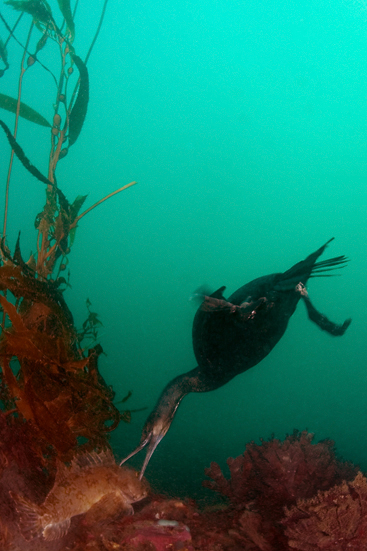
This Brandt's cormorant (Phalacrocorax penicillatus) has it in mind to
make a meal out of this adult cabezon (Scorpaenichthys marmoratus) who's
guarding a nest full of eggs. As you can see, cabezon are not the smallest of
fishes when fully grown.
"Tanker Reef", Monterey Bay, California
January 13, 2007
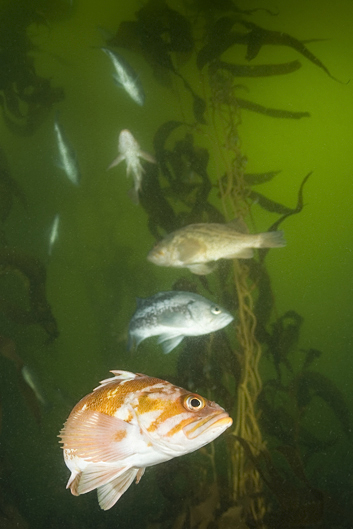
Proof that you can still have fun in four foot visibility. Yes, there are
certainly challenges to taking pictures in water that resembles oobleck
(remember your Seuss?), but I'm actually quite fond of the Mountain Dew
background that only the most intense plankton blooms cause. Here, a variety of
rockfish can be seen at various distances into the muck. From front to back: A
copper rockfish (Sebastes caurinus), a black rockfish (Sebastes
melanops), and a brown rockfish (Sebastes auriculatus). The latter is
also commonly called a Bolinas after the Marin county town which is presumably
host to a large number of them. Bolinas (the town), of course, is far more
famous for other things. Most of all, this sleepy surfing town is famous for its
dislike of visitors. In an ongoing battle with CalTrans, Bolinas residents are
quick to remove any and all highway signs which might aid in locating the town.
Paradoxicly enough, however, should you pass all the hurdles placed before you
and successfully navigate to Bolinas, some of the local shops will be more than
happy to sell you a T-shirt emblazoned with the likeness of the "Bolinas 2mi"
highway sign which wasn't on the highway to mark the appropriate exit.
"Tanker Reef", Monterey Bay, California
July 30, 2006
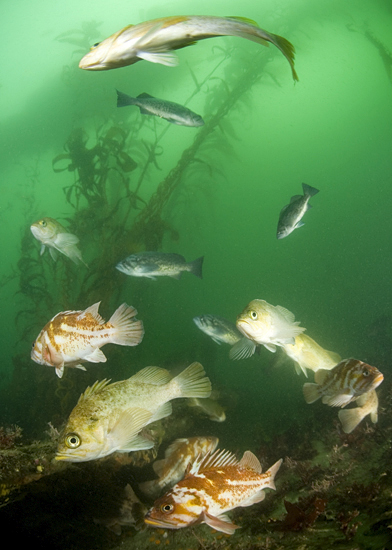
This is my entrant in the "How many different species of rockfish can you fit in
a single photograph?" competition. I think there are five different members of
the genus Sebastes here. That is, blue (S. mystinus), kelp (S.
atrovirens), copper (S. caurinus), black and yellow (S.
chrysomelas) and the fairly uncommon, at least for the Monterey area, brown
(S. auriculatus). There are actually two specimens each of the last two
species, but all four fish are fairly well hidden.
"Tanker Reef", Monterey Bay, California
July 23, 2006
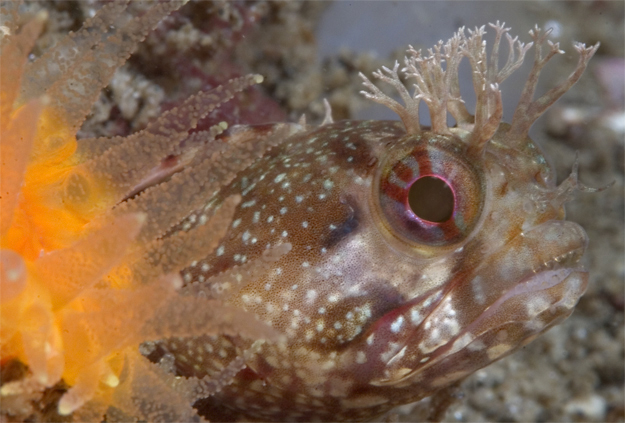
It's often quite difficult to figure out the scale of subjects in underwater
photographs. If the photographer is taking pictures of something quite small,
like this yellowfin fringehead (Neoclinus stephensae), and wants everyone
viewing the picture to know the scale, then, it's a good idea to include some
kind of reference item in the shot itself. This image uses an orange cup coral
(Balanophyllia elegans) for this purpose. While the cup coral, like the
fringehead, is likely unfamiliar to the viewer, the transparency of its arms are
an almost sure indication if its size.
"Tanker Reef", Monterey Bay, California
April 15, 2006
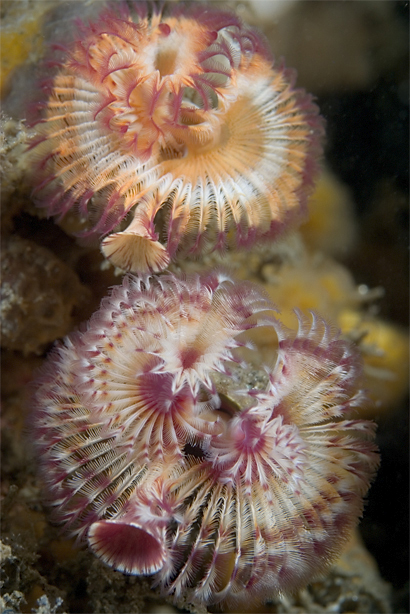
If Dr. Seuss engineered a tube worm, I suspect he might have come up with
something like these two Surpula vermicularis. A classic, example of an
animal that is ubiquitous but seldom photographed, surpulids retreat into their
calcerous tubes should a would-be photographer so much as cast a shadow in their
vicinity. Not surprisingly, shots like this one can be something of an extended
project. I'll likely return to this spot to work on it some more.
"Tanker Reef", Monterey Bay, California
April 15, 2006
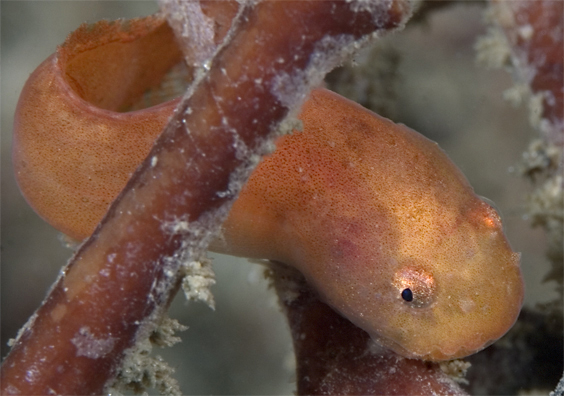
This showy snailfish (Liparis pulchellus) lacks the purple stripes
displayed by other specimens. However, I think this animal's oddly scalloped
upper lip still makes it a worthy photographic subject.
"Tanker Reef", Monterey Bay, California
February 4, 2006
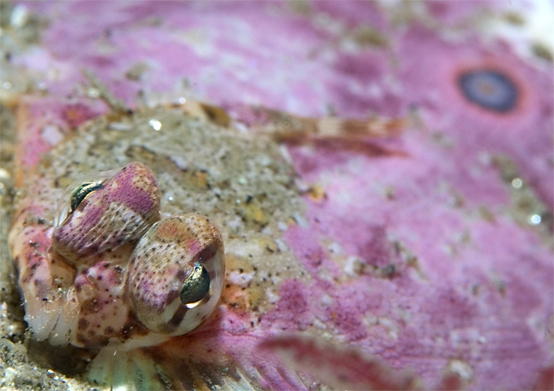
C-O soles (Pleuronichthys coenosus) are named for a distinctive pattern
on their caudal fin that looks like (yup, you guessed it) the letter "C"
followed by the letter "O". This one has gone a little crazy trying to match the
color of some coralline algae. The color scheme makes it appear the animal's
pectoral fin is, in fact, the tail of some smaller fish with gigantic, bulbous
eyes. Unfortunately for me, this is something I didn't notice until I sifted
through the day's pictures -- I dismissed this as a worthy subject prematurely
"Tanker Reef", Monterey Bay, California
April 15, 2006
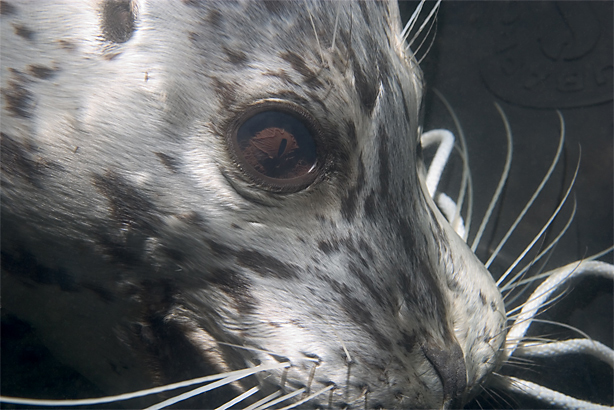
Ever seen a harbor seal (Phoca vitulina) tie a pair of shoes? . . . Me
neither. However, as this photo demonstrates, they are quite adept at UNtying
them. Other harbor seal skills (not pictured) include a knack for removing masks
and drysuit hoods, and, a disturbing ability to dislodge boat anchors from their
resting place in the sand.
"Tanker Reef", Monterey Bay, California
September 18, 2005
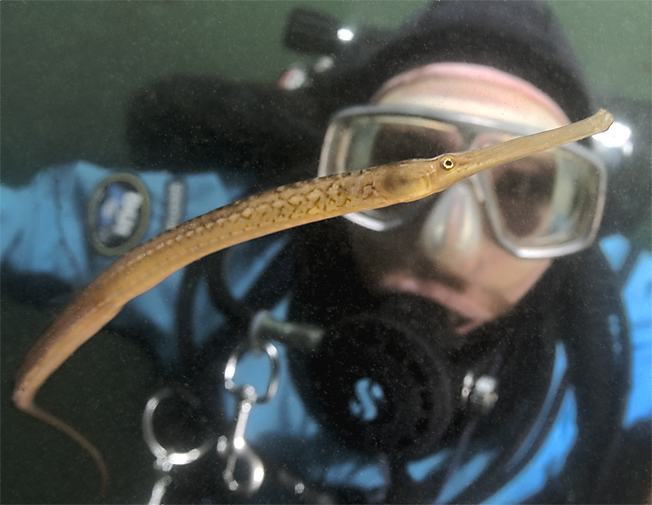
Clinton Bauder takes a close look at a pipefish (Syngnathus sp.).
"Tanker Reef", Monterey Bay, California
January 15, 2006
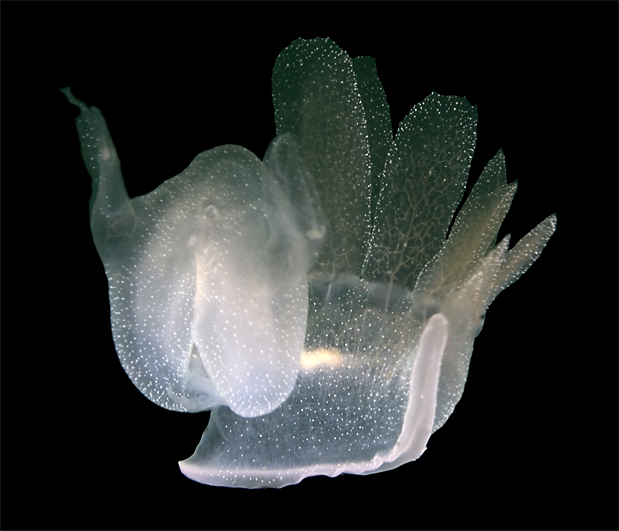
Lion's mane nudibranchs (Melibe leonina) are frequently seen swimming in
open water.
"Tanker Reef", Monterey Bay, California
January 30, 2005
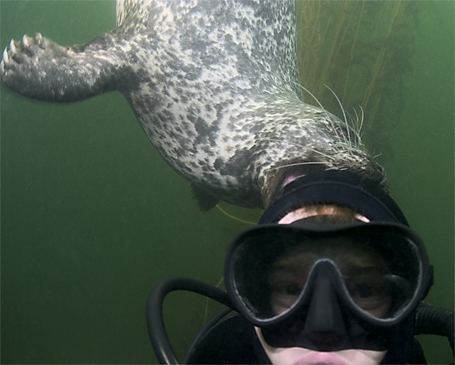
Self-portrait of me having something of a bad hair day. Yes, I had a horrible
headache after this dive. This rather interesting harbor seal (Phoca
vitulina) behavior isn't nearly as threatening as it appears. On one
occasion, however, a seal managed to work a tooth under the stitching of my
drysuit hood. This gave the animal an excellent purchase and a battle for
possession of my hood (and mask!) ensued.
"Tanker Reef", Monterey Bay, California
October 8, 2005
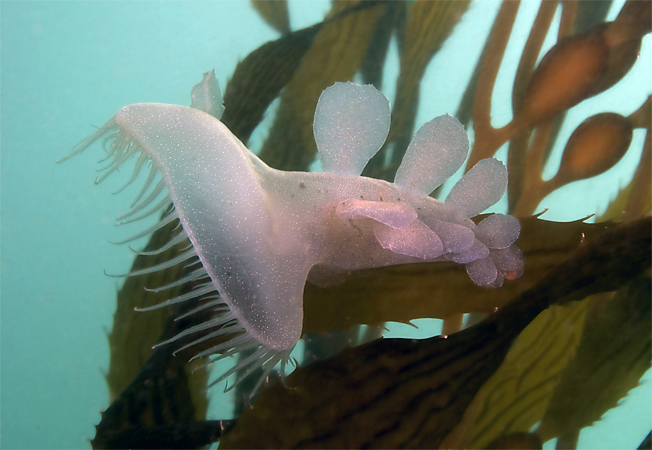
This lion's mane nudibranch (Melibe leonina) is using its massive oral
hood to capture tiny prey that drifts on the passing current.
"Tanker Reef", Monterey Bay, California
January 30, 2005

Home
